First I would like to give a shout out to Beverly Bert (better known as Masiry on microminis group) as she is the one that really inspired this project and I used her tutorial for 1:144 scale mushroom as my starting point for this 1:48 scale one.
I think it is no coincidence that sharing of projects by others inspires us to make things ourselves.
My family is very supportive of my miniature hobby. My daughter is interested to the point of having a 1:12 scale dollhouse and also being interested in doing new projects. I often tell my family about projects I see that have been shared by others. I told my daughter about the mushroom tutorial and she wanted to see the photos. She commented after seeing them that it would be something she would like to do. She even suggested that we could do this in 1:48 scale. Be still my heart. 1:48 scale is my preference, she prefers 1:12 scale. I often enjoy looking at 1:144 or other scales, but seem to come back to the 1:48 scale.
Her birthday was coming up so I bought her a dome and base for this project.
At the same time I started this project, I started two others: The Egg House and The Crooked House still in process. Both of the others go in a 8 x 12 inch dome and have similar aspects so it was easy to work on messy stuff at the same time.
In deciding to do any project (even a kit) there are decisions to be made. In this case, I had some help in Maisry’s tutorial, but I had to adapt it to 1:48 scale. Deciding to use a 8 x 12 inch glass dome to display was a big help in the decision how big it could be.
The following is grouped based on what area of the mushroom and not necessarily in the order to make it or the order I worked on it. I am including where to hold off on doing something to that particular area.
BASE
Since a 12 inch dome is fairly tall for a mushroom, I decided to include a landscaped base to go on the wooden base for the glass dome. I could have used the wooden base and that would have been fine as well. The landscaped base gave me space for my battery – but in hindsight I could have included the battery in the cap. More on that in the CAP section.
The landscaped base is two thicknesses of builder’s foam. I really love builder’s foam and it is one of my go to products for things like bases. I like using it because it is easy to cut and very sturdy. It is also not messy when cut. It get mine a local hardware store. I usually take my craft knife with me as they sell it in big sheets and I can’t get it to fit my car without cutting it.
To shape this, I used my craft knife to quickly cut away different areas so it was rounded but knew I would do more with the next step.
I used plaster cloth to cover the landscape base to make it more a mound and cover those sharp edges. I buy mine at my local craft store. Check both the craft section and also the train modeling section.

One beautiful thing about plaster cloth is that it will stretch and that includes that it can stretch over a gap. It also makes for a very lightweight project. For this project- two layers of plaster cloth was enough. When using plaster cloth, the instructions say to dip in water, but I say the dipping is just part of it. Once dipped it is important to squeeze the wet cloth to get the plaster wet as well – this helps the plaster to fill in the weave.
After the stem was glued onto this base, I painted it grass green. I also worked on the STONE PATH. See how I did that in that section below.
After the path was done, I spread glue over sections of the green area and applied landscape foam. I do a section at a time so the glue doesn’t get a ‘skin’ on it. I press the foam into the glue and try to leave it to dry before shaking it off. I also like to keep a wet edge of the glue – as in I don’t cover the entire glue section with the foam until I reach the end. Depending on the landscape foam I have gone back and trimmed with scissors if the foam is shaggy like in this project.
I also added a small patch of garden. I should have planned this and did before I started the green. This was painted brown. Then I applied glue to the entire section and sprinkled on brown landscape material. This may have even been used tea leaves. While the glue was still wet I did mound the dirt to make rows.

To make the carrot tops I used a greenery that I think was something for fish tanks. I am not really sure where I got it, but I cut it apart and then inserted each plant into a spot in the dirt. When using materials designed for other applications it is good to think about the material in a different way. This material was several inches long, but I focused on the parts and used that. When adding to the dirt, I used my pointed end tool to make a hole although it wasn’t necessary every time.

Note to self – wait until the landscaping material is dry before switching to the other color. I think I should have done the garden first then the green landscaping instead of the other way around as I had to deal with bits of green in the garden that didn’t belong.
That green round thing in the lower right corner of the garden pic is the on/off button for my lighting. I painted it at the same time as the base but did not glue to the button only around the button.
STONE PATHWAY
I really love how a cobblestone or stone pathway looks. I don’t have access to a lot of small round stones nor do I want to spend hours carving something, so I wanted to find a way to do this that wouldn’t require many hours. So here is my easy way to make a stone path.
I painted the path brown. Then I used the end of a 3/16 inch dowel to dip in gesso and make ovals. These would have peaks and I tried to work them so they didn’t stick up so much. I even tried pressing them down after it had dried a bit. However it wasn’t necessary. I used two layers of the gesso and then sanded. The sanding removed those extra peaks and left the stones uneven which stones would be. I could have sanded then nearly smooth if I wanted.

On the right is the gesso on brown paint, next I painted using a very light brown wash (very watered down paint) and dabbed it with a paper towel to remove a lot of it. I repeated this same wash and wipe process next using a dark charcoal color. The dark wet area shows the wash still on before I wiped it. The left side shows the end result.
STEM
I started with a pint size ice cream container. I decided it wasn’t tall enough so I decided to use the container as a support to make a taller stem. I used thin cardboard and came up with this. I even pieced it as knew I would cover the cardboard later.

This one was fine until I pulled out the rabbits and realized the floors and windows didn’t work with my selected rabbits.
Next I made another stem using thin card from a file folder. I happen to have excess – seems people don’t file things like they used to with the increased use of computers. No reason to throw away perfectly good cardboard.
This second stem was taller than the first. It is just over 8 inches. I only used one layer of cardboard here, but in making a stem for another project I did two layers. Either one or two layers work. The second layer might help with warping but I wasn’t really concerned with that.
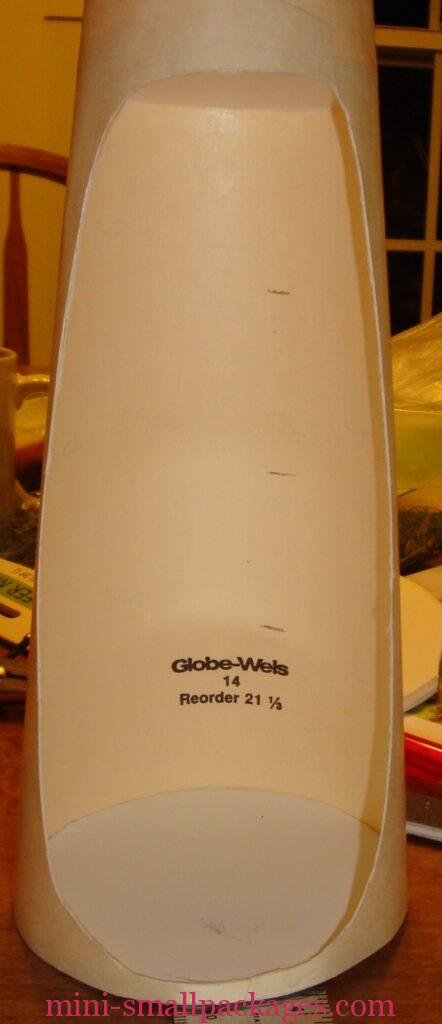
I have already added the bottom floor and the top ceiling. Also you can see the opening is cut and have marked for the floors.
To cut my floors – the two installed – I used foam core board and I used a compass to draw the circles and my craft knife to cut them.
To cut the opening, I sketched a shape using a pencil until I was satisfied with the opening shape. I wasn’t too fussy with the shape or I would have folded a piece of paper in half, cut a half shape and then unfolded to trace around it, I used my craft knife to cut this open.
The other floors were made with matt board. I cut these with scissors but a craft knife would be ok as well. I also cut from very thin card – like index cards – for the ceilings. These were to hide my wiring.
The placement of floors in my mushroom was important relative to the height of my rabbits. My rabbits are on the short side. I choose to use four levels because that is what fit in this size stem.
My stem is angled so the floors were not all the same size. I cut circles first to make sure they matched the curve of the wall. Then I cut them until I was happy with the shape. I cut them in oval shapes as I decided my floors would be offset. Here are the shapes I ended up with

The decision to offset the floors was inspired by the floors in Susie Newell’s firework factory. I had considered adding ladders from one floor to the other, but in the end decided I didn’t want them. Also when I cut the windows and door, I took the placement of my floors into consideration. I wanted my windows to be random not lined up, but I did make a simple template and used that for all of them. When I cut them I didn’t worry too much if I made a tad bigger or smaller opening.
LIGHTING
I used LED chip lights to light the stem. I love the new LED’s, they are so small and so easy to use. Easy to hide being one of the key aspects I love.
Each ceiling paper got a hole punch (I think it is 1/16 th inch) where I wanted the light to go. I glued a smaller piece of paper to cover the gap and also help hold the light into place.


The position of the light was relative to the floor below and not the ceiling.
A small hole to the same side (just poked with my craft knife) allowed each set of wires to come out of the stem.

These wires were untwisted so that I could match colors. It is important with LED’s to not get the colors switched. Thankfully the ones I bought from Evans Designs are colored. I twisted all the red together and all the green together. In this project the two sets of wires were long enough to met up with the switch and battery holder wires. If not, then I would have used an extension wire. I do solder my wires together and then use a heat shrink tube over that.

The wires were soldered to a switch and a battery holder. I used 4 LED’s and a coin cell battery. I cut into the plaster cloth and builder’s foam to position the switch where I wanted it. I like the switch to be even with the base – or the base of the switch even with it which makes the button just above the base level.
I made a hole in the base-bottom to accommodate the battery holder. I choose to not glue the landscaped base to the wood base so that I will be able to change the battery. I debated about putting the battery in the cap, but I was concerned about how I was going to get to it later. Having completed this project and thinking of how I would do it again, I would put the battery in the cap, but have the switch at the bottom. The coin cell and holder are very light and there was room in my cap. The wires would easily go in the other direction it is just a matter of planning.
Once the wiring was connected and working, I added the paper to the stem to keep the wires in place. This paper was just plain copy paper.
When planning the wiring I did plan where my windows were going to be.
OUTER COVERING OF THE STEM
In Maisry’s tutorial she used velvet paper to make the stem and the cap. This was so to give them a look that real mushroom’s have. I decided that velvet paper is a good idea, but not having any on hand I was willing to part with or buy enough to use, I looked for other options. I used file folders for the structure of the stem, but wanted more than that on the outside. Plaster cloth was my choice. I cut the cloth in strips 1-2 inches wide, overlap them. I did two layers of the cloth – smoothing the plaster as much as possible. This just takes time but is really fun, messy but fun.
Some of the windows I cut the cloth while still wet to either remove the window opening or wrap it to the inside.
To make the hoods over the windows, I used plaster cloth. I cut a piece that was 1-2 inches by 1 inch. I waded them and attached with the plaster embedded in the cloth. Some of them had to be trimmed to improve the edges but that can be done wet or dry.
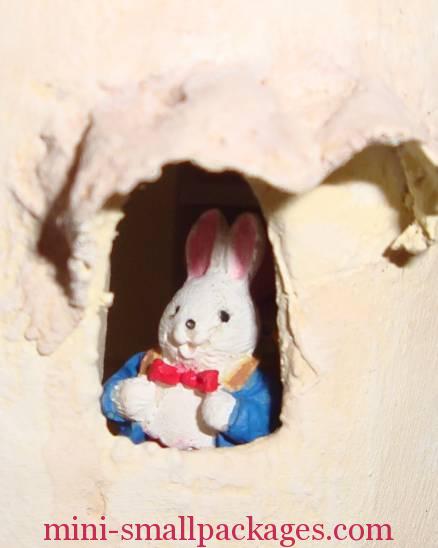
As you can see in this picture, I didn’t try to make the hood match perfectly. To help the plaster cloth disappear, I painted with gesso. I really like gesso as it provides some depth so can fill in spots. Applying it thickly was helpful. Another thing I did while the plaster was wet was capture some of the plaster from the bowl that held the water to wet the cloth. As I work with the cloth a layer of plaster builds up in the bottom of the bowl and this can be reclaimed to fill in spots as well.
Initially I painted the entire stem inside and out the same off white, but the outside was just too flat. I applied a dark brown wash to the outside and wiping as I went. This gave the stem lots of character and improved greatly. I encouraged the wash to antique the stem especially in the hood areas around the windows.
CAP
As I mentioned above, Maisry used velvet paper to make her cap. I had decided that I would use plaster cloth for this as well. In her instructions she worked on the cap inside a bowl. I didn’t have a bowl big enough to do that, although I did have one big enough to work on outside. However as I looked at my glass bowls I wasn’t happy with the curves I was finding. I figured I was going to have to make a structure out of foamcore board or something. Then it dawned on me – I could use the glass dome. The outside of the dome. That worked beautifully!!! It was messy for sure, but it cleans up.
I started with a square piece of plaster cloth that I cut into the sides and laid it on the dome. I spread it and the plaster smoothed out so nicely. The extra cuts into the sides were not necessary due to the fact that the cloth will stretch on the bias. I added several layers. I even did strips. If I were to do again, I would use 3-4 layers of cloth. One thing I was concerned about was the edges. Once it was dry I was able to cut the edges very easily and had no issues with fraying. However I did add strips around the edges overlapping from both under and on the top side. All of these were smoothed to avoid wrinkles although I did some overlapping of the pieces.
I cut a donut shape from foam core board for the underside of the cap. Between this piece and the top of the cap would be room for the wiring. My main concern was breaking the cap if I removed it, so is why I didn’t go with the battery there.
The donut was smaller than the cap so there would be a lip and the inner circle was the size that was needed to fit onto the stem.

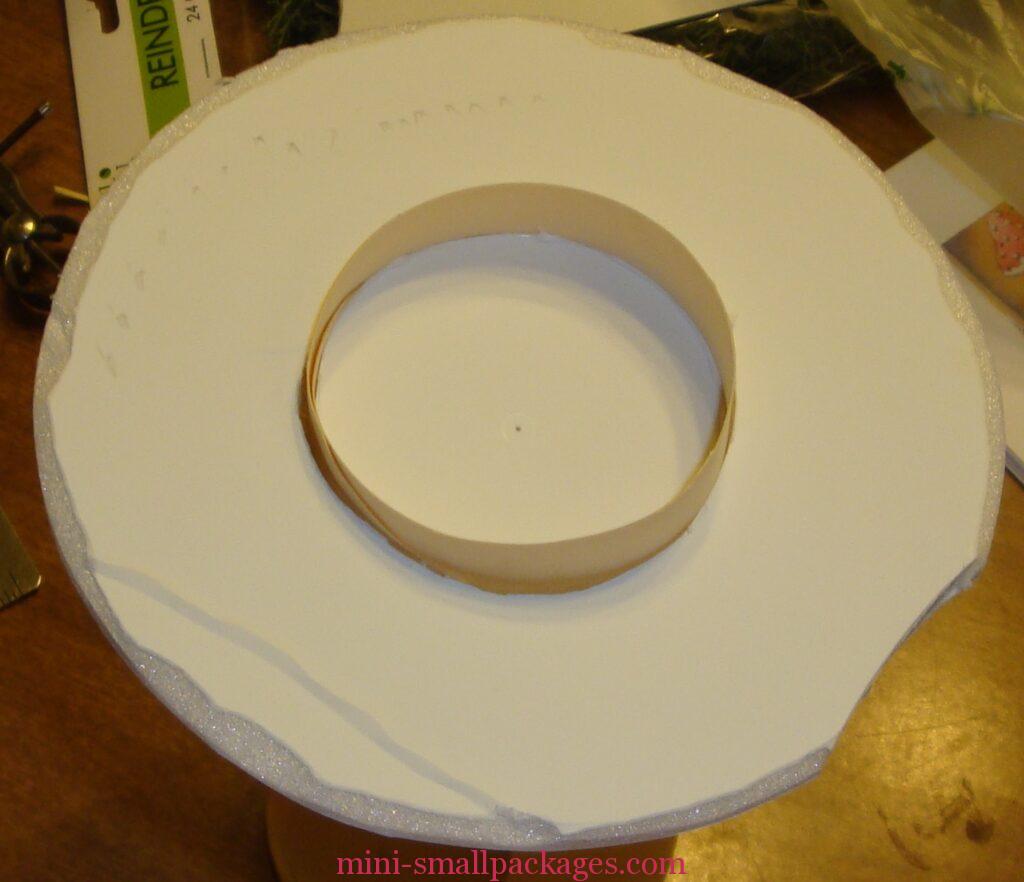
I wanted to simulate the lines under a mushroom cap so I used a thick layer of spackle to fill the gap and then used a sharp tool to draw lines in it while still wet.
I let this dry, but either my eagerness to test fit and pressing the cap into place or just the act of drying the juncture of the donut to the cap cracked so I had to do a second coat to fill in. That was why I was concerned about putting the battery in the cap. However by leaving the cap alone until I was completely ready to glue it in place, I didn’t crack it again and it was very sturdy. But I could have easily left the cap not glued to the stem as the opening fit the stem top well. The stem sticks about 1/2 inch inside the cap.
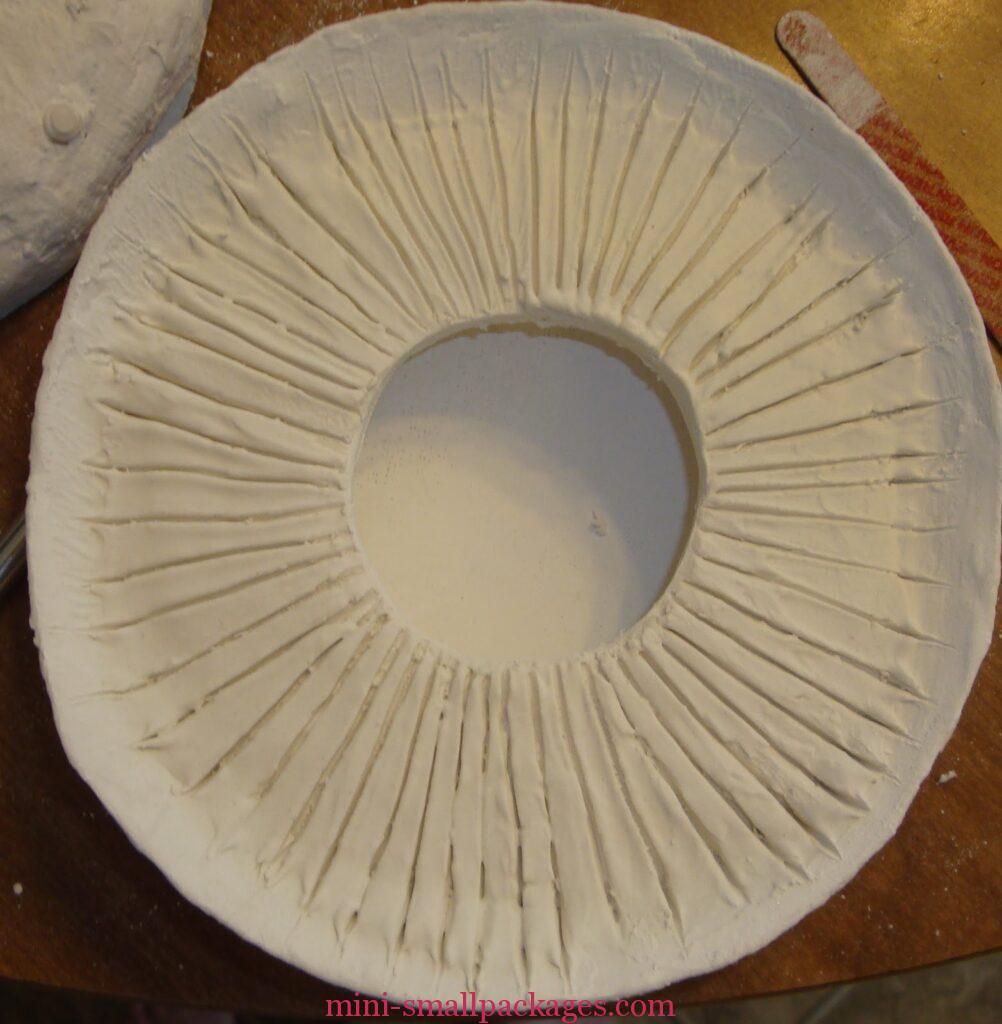

I painted the top of the cap bright red. Wow, that was fun. I also wanted the spots. Looking at pictures I had gotten online the spots seem to be a growth and 3-d, so I used gesso and a 3/16 inch dowel as a dotting tool. This application was purposeful to make the dots peaked. I am very pleased with the results.

RABBITS
The rabbits are all resin. Many of them were ornaments for an egg tree in their former life. I repainted them all. I decided that with a bright red cap that the inhabitants needed to be bright and colorful as well. I know that pastel is often the choice for Easter things, but bright colors are good too. A few of them were modified using my dremel tool.
Here are some before and after.





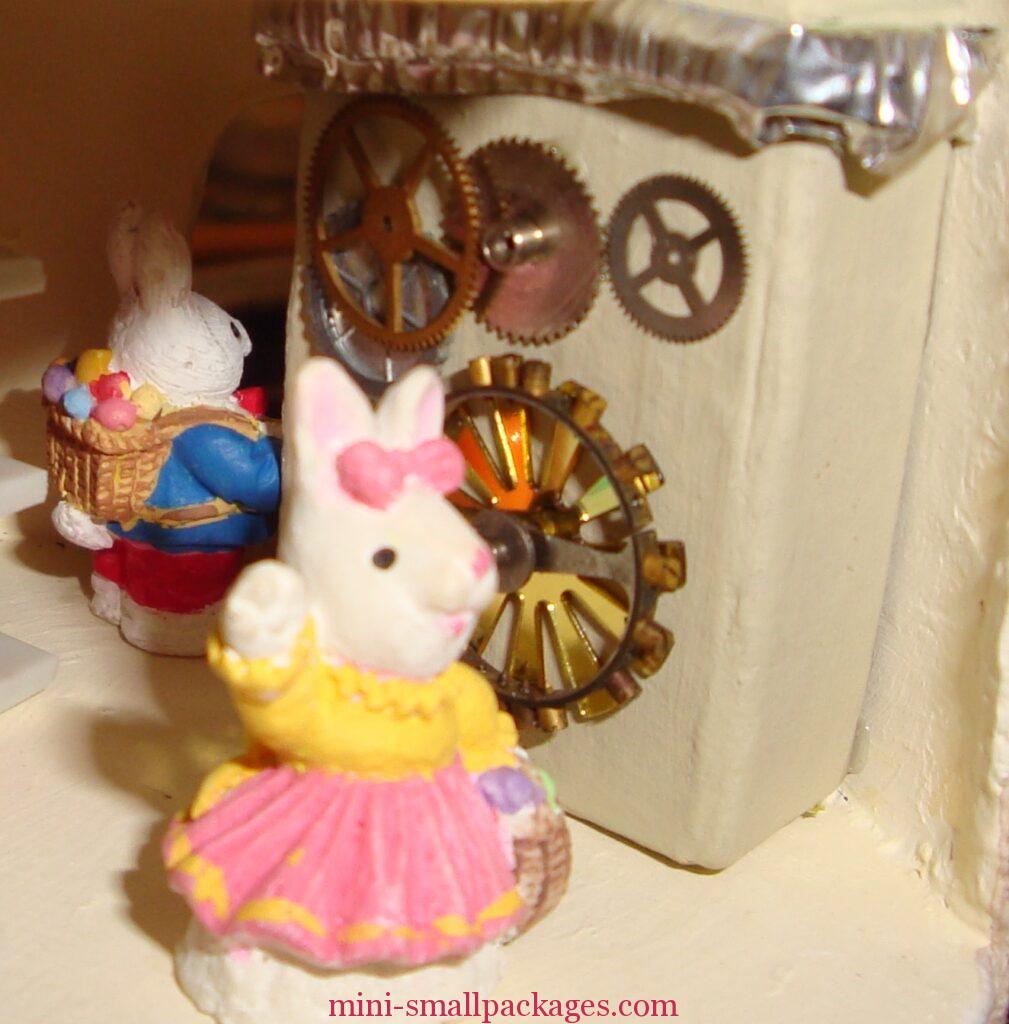

MACHINES AND OTHER ACCESSORIES
The machines were made by using lids from paper mache boxes. The gears and things – were just that – gears from old watches and other odds and ends that I have kept for just such a project.
The idea to add the machines was inspired by Susie Newell’s firework factory.
The paint pots in the color room are perler beads. I used sequins as lids on the ones that were on top. Storage bins in the 2nd floor are pony beads with sequin lids. The shelf units were plastic ones given to me by my father who is an O gauge train enthusist. They were cut in half for another project. I just had to sand them a bit for this one. One the first floor is the other shelf unit and I added seed beads to metal bead caps to make baskets of leftovers.
The table on the first floor was a swap item I made, the two pink fuzzy chairs were a swap I received.
In the nursery, all the items except the rabbits and the pink toy box were swaps to me. I made the toy box as a swap item. I love using my swaps and it is great to have one of your own to finally use as well. The beauty of swaps is getting many handmade items to use without all the work to make them and design them.
PAINTED BASE

After I had painted the base for the winter centerpiece (thanks to Susie Newell for opening up this possiblity), I knew I would paint this one as well. It was just deciding what I would put on it. My daughter was planning to add additional mushrooms to her project and I thought this was my way to do that.
I base coated with a green same as the undercoat for the grass area.
The mushrooms are very freeform shaped. Paint the white stem and cap. Paint the red part of the cap. I tried to leave a slim edge of white at the base of the cap. Then I dotted white spots on the red portion using my double ball stylus. I was intentional in that a few of the mushrooms are taller than the side – meaning they do appear above the side, but not all of them.
Next was the bunny butts – bunnies from behind with an oval, a dot for the tail and two ears. I painted the eggs with plain flat acrylic and then after with metallic. I did paint the bunnies all white at first, but to give more dimension, I added a tiny bit of light brown to my white and painted the hip area again. This was to give the tail a more obvious color difference.

The grass was several colors of green. Some of the grass blades were added intentionally to cover or hide portions of the other things.
The finished base was then coated with modge podge.
Happy miniaturing!
Preble
If you enjoy my website, please consider making a small donation via PayPal.me/minismallpackages. Thank you!